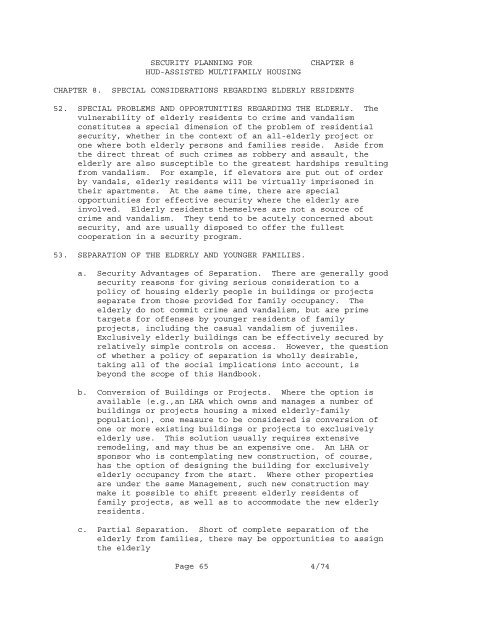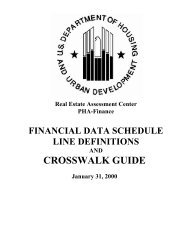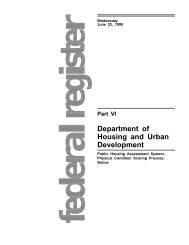SECURITY PLANNING FOR CHAPTER 8 - HUD
SECURITY PLANNING FOR CHAPTER 8 - HUD
SECURITY PLANNING FOR CHAPTER 8 - HUD
Create successful ePaper yourself
Turn your PDF publications into a flip-book with our unique Google optimized e-Paper software.
<strong>SECURITY</strong> <strong>PLANNING</strong> <strong>FOR</strong> <strong>CHAPTER</strong> 8<br />
<strong>HUD</strong>-ASSISTED MULTIFAMILY HOUSING<br />
<strong>CHAPTER</strong> 8. SPECIAL CONSIDERATIONS REGARDING ELDERLY RESIDENTS<br />
52. SPECIAL PROBLEMS AND OPPORTUNITIES REGARDING THE ELDERLY. The<br />
vulnerability of elderly residents to crime and vandalism<br />
constitutes a special dimension of the problem of residential<br />
security, whether in the context of an all-elderly project or<br />
one where both elderly persons and families reside. Aside from<br />
the direct threat of such crimes as robbery and assault, the<br />
elderly are also susceptible to the greatest hardships resulting<br />
from vandalism. For example, if elevators are put out of order<br />
by vandals, elderly residents will be virtually imprisoned in<br />
their apartments. At the same time, there are special<br />
opportunities for effective security where the elderly are<br />
involved. Elderly residents themselves are not a source of<br />
crime and vandalism. They tend to be acutely concerned about<br />
security, and are usually disposed to offer the fullest<br />
cooperation in a security program.<br />
53. SEPARATION OF THE ELDERLY AND YOUNGER FAMILIES.<br />
a. Security Advantages of Separation. There are generally good<br />
security reasons for giving serious consideration to a<br />
policy of housing elderly people in buildings or projects<br />
separate from those provided for family occupancy. The<br />
elderly do not commit crime and vandalism, but are prime<br />
targets for offenses by younger residents of family<br />
projects, including the casual vandalism of juveniles.<br />
Exclusively elderly buildings can be effectively secured by<br />
relatively simple controls on access. However, the question<br />
of whether a policy of separation is wholly desirable,<br />
taking all of the social implications into account, is<br />
beyond the scope of this Handbook.<br />
b. Conversion of Buildings or Projects. Where the option is<br />
available (e.g.,an LHA which owns and manages a number of<br />
buildings or projects housing a mixed elderly-family<br />
population), one measure to be considered is conversion of<br />
one or more existing buildings or projects to exclusively<br />
elderly use. This solution usually requires extensive<br />
remodeling, and may thus be an expensive one. An LHA or<br />
sponsor who is contemplating new construction, of course,<br />
has the option of designing the building for exclusively<br />
elderly occupancy from the start. Where other properties<br />
are under the same Management, such new construction may<br />
make it possible to shift present elderly residents of<br />
family projects, as well as to accommodate the new elderly<br />
residents.<br />
c. Partial Separation. Short of complete separation of the<br />
elderly from families, there may be opportunities to assign<br />
the elderly<br />
Page 65 4/74
<strong>CHAPTER</strong> 8<br />
<strong>SECURITY</strong> <strong>PLANNING</strong> <strong>FOR</strong><br />
<strong>HUD</strong>-ASSISTED MULTIFAMILY HOUSING<br />
to particular mixed buildings or projects, to separate<br />
floors or wings, or to particular units which are more<br />
conducive to their protection. Older residents might be<br />
thus assigned to a building with particularly strong<br />
design and hardware features or with no large families.<br />
d. Locational Factors. The location of the project assumes<br />
particular importance in regard to security for elderly<br />
residents. The prime criterion is a generally low level of<br />
neighborhood crime, although the probable effect of<br />
introducing a large number of vulnerable elderly persons<br />
must be assessed along with favorable conditions. Elderly<br />
residents, whether in an all-elderly project or a mixed<br />
project, should be near shopping, medical clinics, checkcashing<br />
facilities, churches, recreational centers,and<br />
public transportation.<br />
54. <strong>SECURITY</strong> <strong>FOR</strong> THE EXCLUSIVELY ELDERLY PROJECT. Where the<br />
population of the project is exclusively elderly, the key to<br />
good security is keeping unauthorized persons from entering the<br />
premises. The following measures deserve particular attention<br />
in this setting(see Chapter 4 above for further details):<br />
a. Security Within Buildings<br />
4/74<br />
(1) Control of access should not be difficult where an<br />
elderly population is housed in a high-rise structure.<br />
The number of secondary doors should be kept to the<br />
absolute minimum necessary for safety and convenience,<br />
and should be kept locked from the outside at all<br />
times. There should be only one doorway for ordinary<br />
ingress and egress, and its security must receive prime<br />
attention.<br />
(2) Visual monitoring is the best solution to control of<br />
the lobby entrance in all-elderly buildings. This may<br />
be provided by a stationary guard, closed circuit<br />
television, or by positioning the project office so<br />
that Management personnel can maintain surveillance and<br />
control during working hours. Strict screening is more<br />
feasible in all-elderly projects than in those housing<br />
families with children. During all hours when such<br />
measures are not operative, or wholly effective, the<br />
lobby door should be kept locked, and should be<br />
equipped with an annunciator system.<br />
(3) Lobby Surveillance can be further strengthened by<br />
designing the building so that the lobby is an<br />
extension of the lounge or social room, and is thus<br />
visible to persons sitting or participating in<br />
activities in the latter area. Elevators and mailboxes<br />
should also be positioned for high visibility
Page 66<br />
<strong>SECURITY</strong> <strong>PLANNING</strong> <strong>FOR</strong><br />
<strong>HUD</strong>-ASSISTED MULTIFAMILY HOUSING <strong>CHAPTER</strong> 8<br />
from the lobby. An unusual but highly effective design<br />
feature of one high-rise building for the elderly is a<br />
large see-through mirror which permits casual<br />
surveillance of the lobby by the resident manager and<br />
his family from the living room of their adjacent<br />
ground-floor apartment.<br />
(4) Emergency call buttons should be installed within<br />
individual dwelling units. Though primarily designed<br />
for use in medical emergencies, these devices serve a<br />
security function as well.<br />
(5) Electronic surveillance and alarm systems tend to work<br />
well in buildings for the elderly, because of the<br />
cooperation of residents and the relative ease of<br />
distinguishing intruders from residents and their<br />
guests.<br />
b. Security of Grounds. A "fortress" strategy might possibly<br />
be extended to the entirety of the grounds of an elderly<br />
project, with an enclosure and controlled access gates, but<br />
a more common measure is to enclose a yard or terrace as a<br />
protected area for sitting and recreation in high-crime<br />
neighborhoods. Special attention should be given to the<br />
outside approach to the building's entrance. The door<br />
should be near, and clearly visible from, the street; dense<br />
shrubbery or other opportunities for concealment should be<br />
avoided; and the area should be well-lighted. If at all<br />
possible, lobby surveillance should extend to the outside<br />
approach. Parking lots and garages are another type of area<br />
requiring particularly strong security measures in projects<br />
for the elderly. Perhaps the most effective measure for<br />
protecting parking lots is a location near the building<br />
which is subject to continuous surveillance from the lobby<br />
and its approaches, social rooms,and a number of dwelling<br />
units. Lighting should be extraordinarily bright (subject<br />
to energy-conservation measures), because physical<br />
perception diminishes with age.<br />
c. Resident Participation. In exclusively elderly projects,<br />
there is usually a particularly high degree of resident<br />
concern and cooperation regarding security. Ordinarily,<br />
elderly residents feel a strong sense of community, at least<br />
among themselves, and are ready to join enthusiastically in<br />
programs of mutual benefit. Because of their concern and<br />
the fact that they tend to spend much of their time on the<br />
premises, older people provide excellent agents for<br />
surveillance. Moreover, they have the time, as well as the<br />
willingness, to provide appropriate volunteer services<br />
incident to security and related programs. There are<br />
generally excellent opportunities for the involvement of the<br />
residents' organization in a security program. Management
and the residents' organization should make special<br />
Page 67 4/74<br />
<strong>SECURITY</strong> <strong>PLANNING</strong> <strong>FOR</strong> <strong>CHAPTER</strong> 8<br />
<strong>HUD</strong>-ASSISTED MULTIFAMILY HOUSING<br />
efforts to conduct a continuing program of formal and<br />
informal instruction on security, reminding residents of the<br />
functions of particular security measures and how the<br />
resident can best cooperate. In particular, residents<br />
should be clearly informed about electronic surveillance<br />
systems, security personnel, procedures for reporting<br />
offenses or suspicious incidents, procedures for<br />
safeguarding dwellings during extended absences,and how best<br />
to respond to individual confrontations with criminals.<br />
Fears and rumors should receive the prompt attention of<br />
Management and the residents' organization. One protective<br />
measure particularly suited to the exclusively elderly<br />
project is a "buddy system," whereby pairs or groups of<br />
residents take the responsibility for looking out for the<br />
welfare of each other on a daily basis. While this is<br />
widely used for the primary purposes of maintaining an alert<br />
for accidents and other medical emergencies, it is obviously<br />
a useful security measure, particularly for persons living<br />
alone.<br />
d. Community Involvement. While special opportunities for<br />
community involvement in the protection of elderly residents<br />
also extend to those living in mixed elderly-family<br />
projects, all-elderly projects are especially conducive to<br />
this type of assistance. Generally sympathetic community<br />
attitudes toward the elderly can be focused on the<br />
exclusively elderly housing project. Local agencies may be<br />
persuaded to bring their services to the project on a<br />
regularly-scheduled basis, and on-site facilities should be<br />
provided for such services as medical check-ups and<br />
recreational programs. Some all-elderly projects make their<br />
meeting rooms available to neighborhood organizations in<br />
return for various types of direct or incidental involvement<br />
in the lives of the residents. Such arrangements provide an<br />
additional element of surveillance.<br />
55. <strong>SECURITY</strong> <strong>FOR</strong> ELDERLY RESIDENTS OF FAMILY PROJECTS. Where the<br />
elderly live alongside families in the same project, their<br />
security must largely depend upon the general level of security<br />
for the project and all of its residents. However, there are<br />
some special measures which can provide additional protection to<br />
older residents in this situation. Assignment to units with<br />
particularly strong security characteristics has already been<br />
suggested in subparagraph 53c above. A similar technique is to<br />
provide special interior or exterior areas for sitting,<br />
strolling and recreation, restricted to elderly or general adult<br />
use. This at least provides places where the elderly can get<br />
out of their dwelling units without threat or annoyance from<br />
juveniles. It also encourages informal surveillance and social<br />
contacts which further mutual protection. The "buddy system"
can be used in mixed projects, as<br />
4/74<br />
Page 68<br />
<strong>SECURITY</strong> <strong>PLANNING</strong> <strong>FOR</strong><br />
<strong>HUD</strong>-ASSISTED MULTIFAMILY HOUSING <strong>CHAPTER</strong> 8<br />
well as all-elderly projects, and non-elderly residents are<br />
often more than willing to watch out for their older neighbors;<br />
the residents' organization might undertake this and other<br />
services for elderly residents. Even if special security<br />
measures cannot be justified for the benefit of nonelderly<br />
residents alone, the presence of older persons may argue for<br />
their adoption, perhaps on a limited or concentrated scale. For<br />
example, police or security guards might be instructed to<br />
exercise prime surveillance of the elderly and their dwelling<br />
units. If the vulnerability of elderly residents is an<br />
important factor in attracting crime by nonresidents, the<br />
security of all residents can be enhanced by eliminating that<br />
vulnerability.<br />
56. <strong>SECURITY</strong> OFF THE PREMISES. One of the most serious aspects of<br />
security for the elderly is the threat of attack within the<br />
larger neighborhood in which they live. It is often especially<br />
hazardous for the older resident to perform the ordinary errands<br />
necessary to his or her daily life, such as buying groceries and<br />
cashing assistance checks. Residential security for the elderly<br />
must therefore take special account of their security needs<br />
within the larger neighborhood. Identification of relatively<br />
safe, as well as convenient, neighborhood facilities and<br />
pedestrian routes can be helpful as a part of a program of<br />
security eduction for older persons. New elderly residents<br />
should be briefed about especially dangerous areas and advised<br />
of options for safer use. It may be possible to make<br />
arrangements with the police to exercise heavier surveillance<br />
over neighborhood routes and facilities frequented by the<br />
elderly. Merchants, and perhaps crossing guards for school<br />
children, can assist with surveillance of elderly persons. In<br />
many instances, particularly where all-elderly projects are<br />
concerned, merchants and community organizations arrange<br />
transportation for shopping, church attendance, recreational<br />
outings, and other activities. In some communities, merchants<br />
will make free deliveries to the elderly, on a group or<br />
individual basis. Protection may be furthered by arranging for<br />
elderly residents to travel in groups to banks, grocery stores,<br />
churches, clinics, or other points within the neighborhood.<br />
Younger residents, or even police or security guards, may<br />
accompany elderly individuals or groups. In all-elderly lowincome<br />
projects, "check days" (days of the month when assistance<br />
checks are regularly received) may require special protective<br />
arrangements. See paragraph 51 above. Finally, the support and<br />
assistance of the nonresident children or other relatives of<br />
elderly residents should be enlisted to the fullest extent<br />
possible. Such persons often need only suggestions as to how<br />
they may be of help. Among the many possibilities are providing<br />
safe transportation for check-cashing, shopping, and other
errands.<br />
4/74<br />
Page 69

















